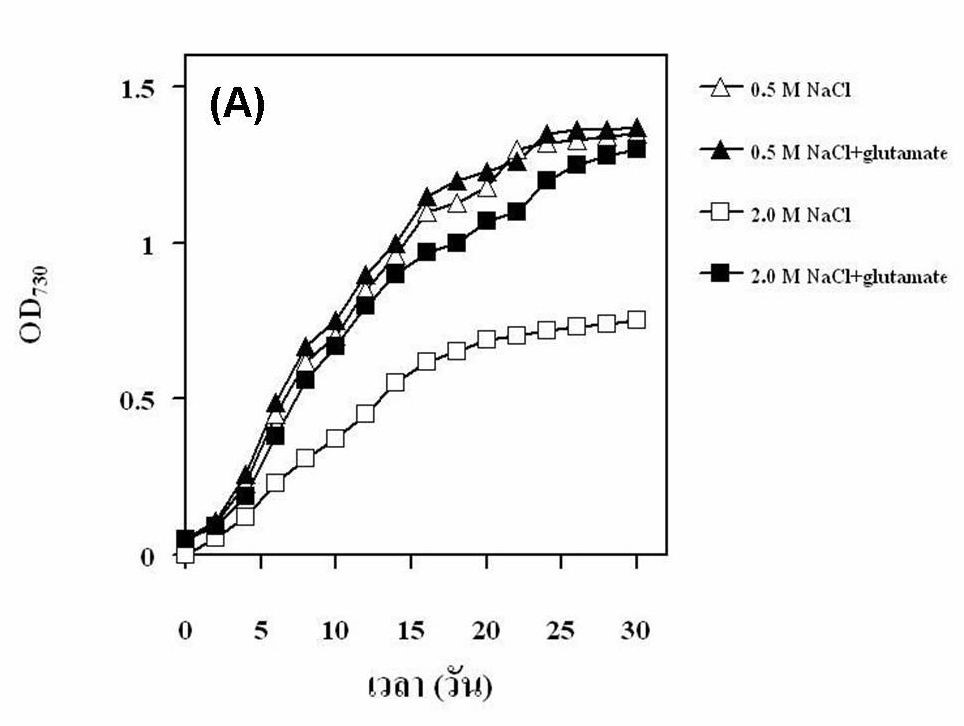ผลของไกลซีน โพรลีน และกลูตาเมต ต่อการเจริญของไซยาโนแบคทีเรีย Synechococcus PCC 7942, Synechocystis PCC 6803 และ Aphanothece halophytica ภายใต้ภาวะปกติและภาวะที่มีความเครียดจากเกลือ
Main Article Content
Abstract
Bongkoj Boonburapong, Aporn Bualuang, Aran Incharoensakdi, Yuwathida Nilapai, Panadda Puangkwan, Arpinyan Boonprakobkul and Surasak Laloknam
รับบทความ: 8 มกราคม 2554; ยอมรับตีพิมพ์: 9 มีนาคม 2554
บทคัดย่อ
จากการศึกษาการเจริญไซยาโนแบคทีเรีย Synechococcus PCC 7942, Synechocystis PCC 6803 และ Aphanothece halophytica ในอาหารเลี้ยง BG11 ภายใต้ภาวะที่มีเกลือโซเดียมคลอไรด์ (NaCl) ความเข้มข้น 0 – 3 โมลาร์ พบว่า อัตราการเจริญที่เหมาะสมภายใต้ภาวะที่มีความเค็มของเกลือ NaCl ต่อไซยาโนแบคเรีย Synechococcus PCC 7942, Synechocystis PCC 6803 และ A. halophytica คือ 0, 0.2 และ 0.5 โมลาร์ ตามลำดับ และภาวะที่มีความเครียดจากเกลือ NaCl ที่ทำให้อัตราการเจริญลดลงเป็นครึ่งหนึ่งของภาวะที่เหมาะสม (ภาวะปกติ) ของไซยาโนแบคเรีย Synechococcus PCC 7942, Synechocystis PCC 6803 และ A. halophytica คือ 0.1, 0.5 และ 2.0 โมลาร์ ตามลำดับ จากนั้นทำการศึกษาผลของกรดอะมิโนอิสระ 3 ชนิด ได้แก่ ไกลซีน โพรลีน และกลูตาเมต ต่อการเจริญของไซยาโนแบคทีเรีย Synechococcus PCC 7942, Synechocystis PCC 6803 และ A. halophytica ภายใต้ภาวะปกติและภาวะที่มีความเครียดจากเกลือ NaCl พบว่า ไกลซีน โพรลีน และ กลูตาเมต ความเข้มข้น 1 มิลลิโมลาร์ไม่มีผลต่อการเจริญของไซยาโนแบคทีเรีย Synechococcus PCC 7942 และ Synechocystis PCC 6803 ภายใต้ภาวะปกติและภาวะที่มีความเครียดจากเกลือ NaCl รวมถึงภาวะปกติของ A. halophytica ในขณะที่ ไกลซีน โพรลีน และกลูตาเมต ความเข้มข้นเดียวกันทำให้อัตราการเจริญของ A. halophytica สูงขึ้นภายใต้ภาวะที่มีความเครียดจากเกลือ NaCl และกลูตาเมตเป็นกรดอะมิโนที่ส่งเสริมการเจริญได้ดีที่สุด โดยมีโพรลีนและไกลซีน รองลงมาตามลำดับ ดังนั้น กลูตาเมต โพรลีน และไกลซีน แสดงสมบัติเป็นสารออสโมโพรเทคแทนต์ที่มีความจำเพาะต่อไซยาโนแบคทีเรียทนเค็ม A. halophytica
คำสำคัญ: ไกลซีน โพรลีน กลูตาเมต ไซยาโนแบคทีเรีย ความเครียดจากเกลือ
Abstract
The growth of cyanobacteria Synechococcus PCC 7942, Synechocystis PCC 6803 and Aphanothece halophytica was stimulated by increasing salinity ranging from 0 – 3 M NaCl in BG11 medium. The optimal growth rate of Synechococcus PCC 7942, Synechocystis PCC 6803 and A. halophytica under salinity was 0, 0.2 and 0.5 M NaCl, respectively. The salt stress condition that half of optimal growth rate of Synechococcus PCC 7942, Synechocystis PCC 6803 and A. halophytica was 0.1, 0.5 and 2.0 M NaCl, respectively. The three amino acids, glycine, proline or glutamate were supplemented in BG11 medium under normal and salt stress conditions. Growth rates of Synechococcus PCC 7942, Synechocystis PCC 6803 and A. halophytica were determined. Additions of 1 mM of glycine, proline or glutamate had no effect on growth rate of Synechococcus PCC 7942 and Synechocystis PCC 6803 at both normal and salt stress conditions as well as normal condition of A. halophytica. However, at the equal level of amino acid could improve growth rate of A. halophytica at salt stress condition. Glutamate was the best amino acid to support growth of A. halophytica and follow by proline and glycine, respectively. Therefore, glutamate, proline and glycine can act as osmoprotectant and has high specificity on growth rate of halotolerant cyanobacterium A. halophytica.
Keywords: Glycine, Proline, Glutamate, Cyanobacteria, Salt stress
Downloads
Article Details

This work is licensed under a Creative Commons Attribution-NonCommercial 4.0 International License.
References
Bohnert, H. J., and Jenzen, R. G. (1996). Strategies for engineering water-stress tolerance in plants. Trends Biotechnol. 14: 89-97.
Eisenhut, M., Bauwe, H., and Hagemann, M. (2007). Glycine accumulation is toxic for the cyanobacterium Synechocystis sp. strain PCC 6803, but can be compensated by supplementation with magnesium ions. FEMS Microbiol. Lett. 277: 232-237.
Hagemann, M., Schoor, A., Jeanjean, R., Zuther, A., and Joset, F. (1997). The stpA gene form Synechocystis sp. strain PCC 6803 encodes the glucosylglycerol-phosphate phosphatase involved in cyanobacterial osmotic response to salt shock. J. Bacteriol. 179(5): 1727-1733.
Kapper, R. M., Kempf, B., and Bremer, F. (1996). Three transport systems for the osmoprotectant glycine betaine operate in Bacillus subtilis: characterization of OpuD. J. Bacteriol. 178: 5071-5079.
Kempf, B., and Bremer, E. (1998). Uptake and synthesis of compatible solutes as microbial stress responses to high-osmolality environments. Arch. Microbiol. 170: 319-330.
Laloknam, S., Tanaka, K., Buaboocha, T., Waditee, R., Incharoensakdi, A., Hibino, T., Tanaka, Y., and Takabe, T. (2006). Halotolerant cyanobacterium Aphanothece halophytica contains a betaine transporter active at alkaline pH and high salinity. Appl. Environ. Microbiol. 72(9): 6018-6026.
Mackey, M. A., Norton, R. S., and Borowitzka, L. J. (1984). Organic osmoregulatory solutes in cyano-bacteria. J. Gen. Microbiol. 130: 2177-2191.
Padan, E., and Schuldiner, S. (1996). Bacterial Na+/H+ antiporters: molecular biology, biochemistry, and physiology. In Handbook of Biological Physics (W.N. Konings, H.R. Kaback and Lolkema, J.S., eds.) pp. 501-531. Elsevier Science, Amsterdam, the Netherlands.
Waditee, R., Bhuiyan, M.N.H., Rai, V., Aoki, K., Tanaka, Y., Hibino, T., Suzuki, S., Takano, J., Jagendorf, A.T., Takabe, T., and Takabe, T. (2005). Genes for direct methylation of glycine provide high levels of glycinebetaine and abiotic-stress tolerance in Synechococcus and Arabidopsis Proc. Natl. Acad. Sci. USA 102: 1318-1323.
Waditee, R., Hibino, T., Nakamura, T., Incharoensakdi, A., and Takabe, T. (2002). Overexpression of a Na+/H+ antiporter confers salt tolerance on a freshwater cyanobacterium, making it capable of growth in sea water. Proc. Natl. Acad. Sci. USA 99: 4109-4114.
Waditee, R., Hibino, T., Tanaka, Y., Nakamura, T., Incharoensakdi, A. and Takabe, T. (2001). Halotolerant cyanobacterium Aphanothece halo-phytica contains an Na+/H+ antiporter, homo-logous to eukaryotic ones, with novel ion speci-ficity affected by c-terminal tail. J. Biol. Chem. 276: 36931-36938.
Zhu, J.-K., Hasegawa, P.M. and Bressan, R.A. (1997). Molecular aspects of osmotics stress in plant. Crit. Rev. Plant Sci. 16: 253-277.
